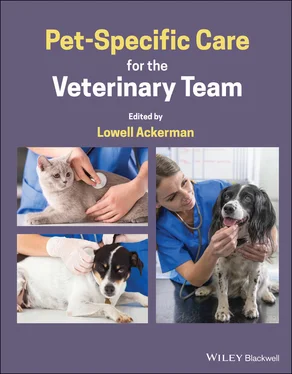When pain works correctly, it is both normal and protective; this is often referred to as “adaptive” pain. If pain becomes exaggerated in some way (duration, scope, character, field), it is then said to be “maladaptive.” Maladaptive pain occurs through a process called “hypersensitization”: a combination of cellular and molecular processes that include lowering firing thresholds of nociceptors, recruitment of “innocent bystander” nociceptors, “cross‐talk” with other neurons such as those responsible for touch, pressure, and sympathetic fibers, and diminished inhibitory control. The molecular and cellular changes of hypersensitization occur in both the peripheral tissue and the spinal cord. The result for the patient is pain that is worse than it should be (“hyperalgesia”), normally nonnoxious stimuli like touch now become painful (“allodynia”), odd sensations that accompany the pain (“dysthesias” like tingling, itch, burning, even numbness), a larger area than originally affected is now painful, pain present for longer than expected, and spontaneous pain without any obvious tissue damage present.
Maladaptive pain can occur through a variety of circumstances, but generally includes nerve injury of some type. This injury can be macroscopic and obvious, or microscopic and inobvious. Taken to the extreme, maladaptive pain of any origin becomes “neuropathic,” whereby permanent changes are encoded into the peripheral and central nervous system. At this point, pain can be said to be a disease unto itself.
Maladaptive pain and/or pain with a neuropathic component can occur under both heritable and acquired, and acute and chronic circumstances. A partial list of these includes but is not limited to the following.
CNS injury, including heritable disorders such as Chiari‐like malformation (Cavalier King Charles spaniels) and acquired ones such as intervertebral disc disease and other spinal trauma, traumatic nerve injury, e.g., amputation, encephalitides.
Any severe tissue trauma.
Persistent postsurgical pain.
Chronic inflammation: OA, lymphoplasmacytic gingivitis/stomatitis, otitis.
Visceral: pancreatitis, feline interstitial cystitis (“Pandora syndrome”) [2], inflammatory bowel disease, glaucoma.
Spontaneous/idiopathic: feline hyperesthesia syndrome, feline orofacial pain syndrome.
In humans, microneuropathies may be caused by diabetes, herpesvirus, and some chemotherapy agents, especially vinca alkaloids; some dogs and cats probably also suffer thus).
2.16.2 Recognition/Assessment of Pain
The IASP stipulates that the inability to communicate (e.g., neonates, the cognitively impaired) does not negate the possibility that an individual is experiencing pain and is in need of appropriate pain‐relieving treatment. In humans, pain is what the patient says it is; in animals (as in human neonates and the cognitively impaired), the pain is what we (the veterinary team) say it is.
The astute veterinary team can prompt pet owners' awareness and recognition that their pets are exhibiting either obvious or subtle clinical (or even historical) signs of pain (see 8.13Team Approach to Pain Management). Observations of poor patient conformation, body position, gait and mobility, or a client report – even just over the phone or other communication – of “stiffness,” lameness, or reluctance to perform activities of daily living (including just getting up and down on or off furniture, etc.) can be enough to say “Sounds (or looks) like she may be uncomfortable,” followed by one or more of the following.
We'll have the doctor take a look at that.
Tell me more about what you are seeing at home.
Let's see if we can't improve that.
This type of introductory language can help to move the conversation, exam, and management choices forward, which can subsequently have a significant positive impact on patient quality (and perhaps length) of life. It can be initiated by front desk personnel taking calls and watching pets in reception area, technicians and veterinary assistants escorting to the exam room and talking to owners, and animal caretakers interacting with the patients under their care.
In the absence of vocalizing, lameness, and other obvious signs of pain, the veterinary team can be mindful of the following observable changes in body conformation and mobility.
Visible conformation: high body condition score (BCS); kyphosis (bowing up) of back, diminished angle to stifle and hock, obvious muscle atrophy (denotes a patient that has been shifting weight forward for considerable time); cow‐hock, base narrow or wide, chondrodyplasia – all evident at a glance.
Dog sitting “square” or cheating on one hip (likely stifle pain)?
When stands from a lying position, should be all four legs simultaneously versus rising up first on forelimbs followed by hoisting up the rear quarters.
Gait if possible – stilted or fluid? Lameness: look for a “quick step” which suggests the contralateral limb is affected; look for classic “wiggle” of rear quarters seen as the dog rotates its pelvis to reduce painful extension of the hip.
Jumping up or standing on back legs easily, partially, or unable/unwilling?
Several clinical metrology instruments (CMIs) are validated for both dogs and cats to assign scores for acute postsurgical pain (examples: Glasgow Composite Measure Pain Scale for dogs and cats, UNESP‐Botucatu Multidimensional Composite Pain Scale for cats). They utilize the domains of observing the patient without interaction (with focus on position in cage, posture, behavior, facial expression), then with interaction (willingness to interact and move), then palpating the incision site. A nonvalidated but simple tool is to apply a global 0–10 score of those domains taken together, whereby 0 is no pain at all and 10 is the worst possible pain for that procedure ; this is a so‐called dynamic interactive visual analog scale (DIVAS) and can be quickly and easily deployed in any practice setting. It can be argued that the most important of those domains is palpation of the surgical site, and if so the simplest assessment method of all would be to assign a 0–4 score based on this maneuver alone.
Several CMIs also exist for chronic OA‐related pain and disability in dogs (e.g., Canine Brief Pain Inventory, Liverpool OA in Dogs, Canine OA Staging Tool in Dogs) and cats (e.g., Feline Musculoskeletal Pain Index, Montreal Instrument for Cat Arthritis). These assess various domains of owner‐ (not veterinarian) observed signs of discomfort and limitations on activities of daily living.
2.16.3 Prevention and Treatment of Pain
Industry guidelines and consensus statements have been published on the highest, wisest, and safest use of modalities to prevent and control surgical and OA‐related pain [3, 4]. Additional discussions are available elsewhere (see 6.14Pain Prevention, Management, and Conditioning, and 8.13 Team Approach to Pain Management). High‐level concepts include the following.
2.16.3.1 Acute Postsurgical Pain
1 Anxiolysis, to include both pharmacological and nonpharmacological measures.Anxiolytics such as trazodone and gabapentin administered the morning of surgery, even by the owner at home prior to transport to the hospital.Fear‐free experience, low‐stress handling, pheromone therapy, comfortable species‐specific housing (see 6.6Fear Free Concepts).Anxiolytic administered as part of in‐hospital premedication, e.g., midazolam, dexmedetomidine, acepromazine (when administered with opioids).
2 Opioid – while this remains the most effective drug class for acute pain, veterinary clinicians are advised [5] to follow the shift in human medicine to use fewer opioids, lower doses, shorter frequency, and insofar as possible shift from full mu agonists (morphine, hydromorphone, fentanyl) to partial mu agonists (e.g., buprenorphine) and mu antagonists, kappa‐agonist (e.g., butorphanol). Consensus statements support the aggressive use of opioid‐sparing strategies (the other modalities discussed in this section), and reserving full mu agonists for the prospectively more painful procedures and patients.
Читать дальше












